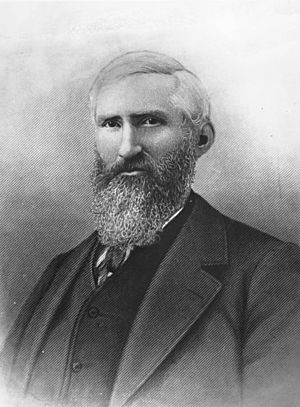John Reid Wolfskill facts for kids
John Reid Wolfskill (born September 16, 1804 – died May 27, 1897) was an important pioneer in California. He helped start the state's farming industry in the Sacramento Valley during the 1800s. In 1842, John Wolfskill was the first person to plant vineyards and fruit trees in that area.
He was born in Kentucky and later moved to California. There, he joined his brother William and they bought land near Sacramento. John Wolfskill became a pioneer in Solano County. He was the first English-speaking person to settle near what is now Winters, California.
His brother, William Wolfskill, also helped California's farming grow, especially around Los Angeles. Later, John's younger brothers, Milton, Mathus, and Sarchal, joined him. They lived on his large land grant called Rancho de los Putos, which was later known as the Wolfskill Ranch. In 1935, Wolfskill's family gave 100 acres of the ranch to the University of California, Davis. This land is still used today as a special orchard for experiments.
Contents
John Wolfskill's Early Life
John Wolfskill was born on September 16, 1804, near Richmond, Kentucky. His parents were Joseph and Sarah Reid Wolfskill. His family moved from Kentucky to Missouri in 1809. They settled near Boone's Lick, close to the Missouri River. This area was growing fast because of the fur trade. John and his brothers and sisters grew up on the frontier, which was the edge of settled lands.
Adventures and Career Beginnings
In 1828, John Wolfskill left Missouri and traveled to Santa Fe, New Mexico. At that time, Santa Fe was part of independent Mexico. His older brother, William, had already been there for ten years, working as a fur trapper. From Santa Fe, John traveled deeper into Mexico, visiting places like Durango and Chihuahua. For four years, he worked as a guard. His job was to protect silver being moved between Chihuahua and Matamoros. He made eleven such trips!
After his adventures, Wolfskill sailed from Matamoros to New Orleans. Then he traveled up the Mississippi River to return to his home in Missouri. He lived and worked there for a few years. In 1836, he went back to New Mexico. He planned to buy mules to sell in Missouri, but Native Americans stole all his mules. He then decided to join his brother William in Los Angeles.
Starting a Farm in California
John's brother William had become a Mexican citizen. This allowed him to own a large piece of land in California. In May 1842, William received a land grant near what is now Winters, California. This area is in Yolo County. When John joined him, they named their property Rancho Rio de los Putos. The name came from a nearby creek. Spanish settlers had named the creek using words from the Lake Miwok language, meaning "grassy creek."
Later, John's three younger brothers, Milton, Mathus, and Sarchal, also came to live on the ranch. In 1842, John Wolfskill was the first person to plant fruit trees and vineyards in this area.
By 1851, Wolfskill was growing crops along Putah Creek. He also started an orchard and vineyard in the Sacramento Valley. He bought fig, pear, and English walnut trees, and grape cuttings from Los Angeles.
At first, the ranch was mainly used for raising animals. They sold meat to the many mining camps that were booming during the California Gold Rush. In the 1860s, John and his brothers changed their focus to growing wheat. They built fences around their land to keep animals out. John and William divided their ranch, each taking half. John focused most of his land on growing fruit. A train line was even built across the ranch, with the nearest station being Winters. William mostly stayed in Los Angeles, where he was very important in farming development there.
Family Life
In 1858, when he was 54 years old, John Wolfskill married Susan Cooper. They had four children together: a son named Edward, and three daughters named Melinda, Jennie, and Frances.
John Wolfskill eventually divided his large ranch among his children. In his later years, he lived with his married daughter Frances and her husband, Samuel Taylor. John Wolfskill passed away in 1897.
John Wolfskill's Legacy
- In 1935, John Wolfskill's family gave 100 acres of the Wolfskill Ranch in Winters to the University of California, Davis. This land is used for an experimental orchard, helping scientists learn more about growing fruit.
- His nephew, Timoteo, was a partner in a dry goods store called Lazard & Wolfskill. This store later became a famous department store in Los Angeles called the City of Paris.


